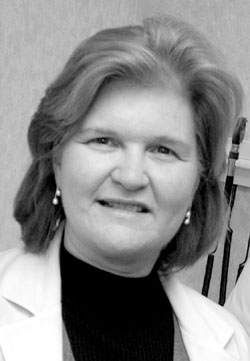
Dr. Mary Yarbrough leads the Health and Wellness Programs. (photo by Dana Johnson)
Keeping fit: Vanderbilt garners national health achievement award
Vanderbilt University and Vanderbilt University Medical Center are the first institute of higher education and academic medical center to receive a national award for health and wellness programs from the American College of Occupational and Environmental Medicine (ACOEM).
More than 40 national and international organizations competed for the 2002 Corporate Health Achievement Award. As part of the competition, organizations submitted a comprehensive application about their health and wellness programs and underwent a rigorous review and site evaluation of the programs. A team of occupational medicine physicians assessed four categories: healthy people, healthy environment, healthy company and management and leadership.
Vanderbilt joins a prestigious list of previous winners including Johnson & Johnson, Dow Chemical, Eli Lilly and Lockheed Martin.
“Winning the Corporate Health Achievement Award is a wonderful acknowledgement of our commitment to protecting the health and well-being of Vanderbilt’s most valuable asset — its faculty and staff,” said Dr. Mary Yarbrough, director of Health and Wellness Programs.
Vanderbilt’s Health and Wellness Programs, a section of Human Resource Services and the Division of Administration, include the Occupational Health Clinic, Employee Assistance and Physician’s Wellness programs, Health Plus and the Child Care Centers.
“Providing a safe, healthy and environmentally friendly work environment for our employees is a top priority for the University,” Chancellor Gordon Gee wrote in a letter to the ACOEM program. “I truly believe that a major part of Vanderbilt’s continuing success is its offering of programs such as these to our faculty, staff and students.”
The purpose of the Corporate Health Achievement Award (CHAA) is to foster awareness of quality employee occupational and environmental medical programs; identify model employee health programs and outstanding practices with measurable results; and encourage organizational self-assessment and continuous improvement.
During a two-day site visit, different components of Vanderbilt’s Health and Wellness programs were recognized as exemplary. They included:
• The Employee Assistance Program’s Physician Wellness section, led by Dr. Paul Ragan, Ellen Trice, and Jim Kendall, which recognizes that in addition to unique job demands, physicians are exposed to the same kind of stressors as everyone else and provides focused needs assessments for physicians.
• The Occupational Health Clinic’s use of real-time information to manage regulatory compliance programs, such as the compliance with the Medical Center’s TB skin testing policy.
• Continuous quality improvement projects, under the guidance of Health and Wellness biostatistician Dan Byrne. Examples of these projects include tracking and comparison of needlestick rates related to mechanisms of injury before and after corrective interventions, conducted by Pat Kinman; tracking and comparison of staff members’ participation in regulatory medical surveillance programs before and after the implementation of steps designed to improve compliance, coordinated by Sharon Sulkin; and tracking and comparison of the percentage of TB skin tests that were read before and after the implementation of making phone calls to remind faculty/staff to have TB skin tests read, led by Helen Scott.
• Health Plus’ increase in the number of health risk assessments completed by faculty and staff and the use of aggregate data obtained from these assessments to design health and productivity programs, led by Marilyn Holmes and staff.
Reviewers also looked at participation rates for regulatory compliance programs, work-injury/illness rates, return-to-work trends, participation rates for health risk assessments and the effectiveness of risk reduction programs, penetration rates for employee assistance programs, and outcome measures of drug and alcohol rehabilitation programs.
“This is a huge accomplishment,” said Paula McGown, administrative officer for Health and Wellness. “This could not have been accomplished without extraordinary team work throughout the University and Medical Center.”













